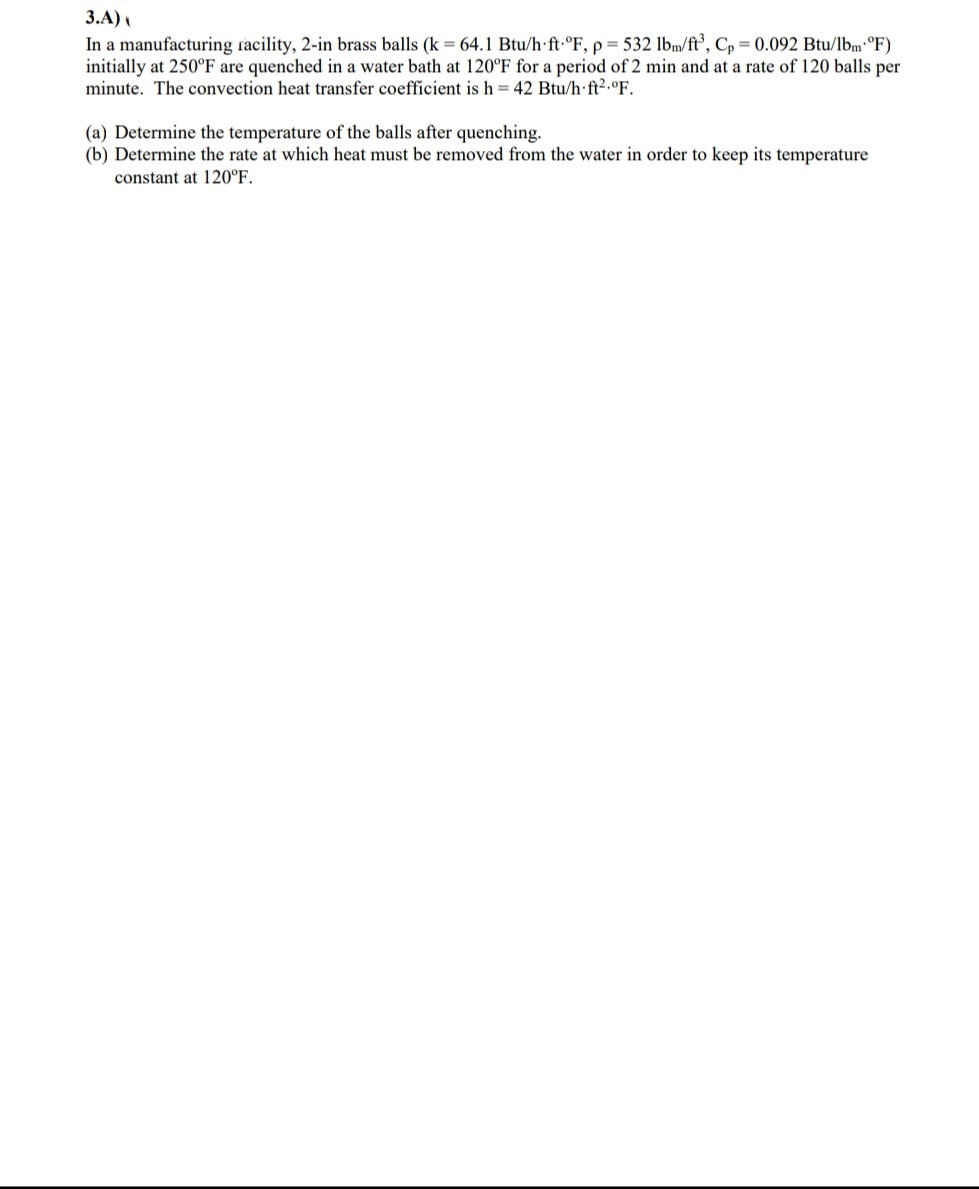3.A), In a manufacturing racility, 2-in brass balls (k = 64.1 Btu/h ft-°F, p = 532 lbm/ft', Cp = 0.092 Btu/lbm-°F) initially at 250°F are quenched in a water bath at 120°F for a period of 2 min and at a rate of 120 balls per minute. The convection heat transfer coefficient is h= 42 Btu/h ft2.°F. (a) Determine the temperature of the balls after quenching. (b) Determine the rate at which heat must be removed from the water in order to keep its temperature constant at 120°F.
3.A), In a manufacturing racility, 2-in brass balls (k = 64.1 Btu/h ft-°F, p = 532 lbm/ft', Cp = 0.092 Btu/lbm-°F) initially at 250°F are quenched in a water bath at 120°F for a period of 2 min and at a rate of 120 balls per minute. The convection heat transfer coefficient is h= 42 Btu/h ft2.°F. (a) Determine the temperature of the balls after quenching. (b) Determine the rate at which heat must be removed from the water in order to keep its temperature constant at 120°F.
Introduction to Chemical Engineering Thermodynamics
8th Edition
ISBN:9781259696527
Author:J.M. Smith Termodinamica en ingenieria quimica, Hendrick C Van Ness, Michael Abbott, Mark Swihart
Publisher:J.M. Smith Termodinamica en ingenieria quimica, Hendrick C Van Ness, Michael Abbott, Mark Swihart
Chapter1: Introduction
Section: Chapter Questions
Problem 1.1P
Related questions
Question

Transcribed Image Text:3.A)
In a manufacturing racility, 2-in brass balls (k = 64.1 Btu/h ft-°F, p= 532 lbm/ft’, Cp = 0.092 Btu/lbm°F)
initially at 250°F are quenched in a water bath at 120°F for a period of 2 min and at a rate of 120 balls per
minute. The convection heat transfer coefficient is h = 42 Btu/h ft2.°F.
(a) Determine the temperature of the balls after quenching.
(b) Determine the rate at which heat must be removed from the water in order to keep its temperature
constant at 120°F.
Expert Solution
This question has been solved!
Explore an expertly crafted, step-by-step solution for a thorough understanding of key concepts.
Step by step
Solved in 3 steps

Knowledge Booster
Learn more about
Need a deep-dive on the concept behind this application? Look no further. Learn more about this topic, chemical-engineering and related others by exploring similar questions and additional content below.Recommended textbooks for you

Introduction to Chemical Engineering Thermodynami…
Chemical Engineering
ISBN:
9781259696527
Author:
J.M. Smith Termodinamica en ingenieria quimica, Hendrick C Van Ness, Michael Abbott, Mark Swihart
Publisher:
McGraw-Hill Education

Elementary Principles of Chemical Processes, Bind…
Chemical Engineering
ISBN:
9781118431221
Author:
Richard M. Felder, Ronald W. Rousseau, Lisa G. Bullard
Publisher:
WILEY

Elements of Chemical Reaction Engineering (5th Ed…
Chemical Engineering
ISBN:
9780133887518
Author:
H. Scott Fogler
Publisher:
Prentice Hall

Introduction to Chemical Engineering Thermodynami…
Chemical Engineering
ISBN:
9781259696527
Author:
J.M. Smith Termodinamica en ingenieria quimica, Hendrick C Van Ness, Michael Abbott, Mark Swihart
Publisher:
McGraw-Hill Education

Elementary Principles of Chemical Processes, Bind…
Chemical Engineering
ISBN:
9781118431221
Author:
Richard M. Felder, Ronald W. Rousseau, Lisa G. Bullard
Publisher:
WILEY

Elements of Chemical Reaction Engineering (5th Ed…
Chemical Engineering
ISBN:
9780133887518
Author:
H. Scott Fogler
Publisher:
Prentice Hall


Industrial Plastics: Theory and Applications
Chemical Engineering
ISBN:
9781285061238
Author:
Lokensgard, Erik
Publisher:
Delmar Cengage Learning

Unit Operations of Chemical Engineering
Chemical Engineering
ISBN:
9780072848236
Author:
Warren McCabe, Julian C. Smith, Peter Harriott
Publisher:
McGraw-Hill Companies, The